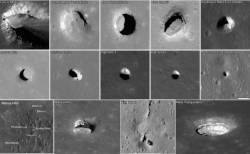Moon
Lunar Caves

Before we left our own planet the first time, we had very little information on other planets. There was much room for fantasy, and some ideas have proven unrealistic. One of them is obviously the theory of ice and air filled caves on the Moon, postulated in science fiction stories and shown in 1950s science fiction B-movies.. But still the last word on caves on Moon is not spoken.
The moon has no atmosphere and so, despite the enormous temperature changes by day and night, no weathering happens.
 Lava tubes
are formed by flowing lava, where the outside cools down and forms a tunnel, while the lava still flows inside.
This could happen on Moon, if there is volcanism.
Theoretically.
Lava tubes
are formed by flowing lava, where the outside cools down and forms a tunnel, while the lava still flows inside.
This could happen on Moon, if there is volcanism.
Theoretically.
The volcanism on moon is proven by samples, brought back by various Apollo missions.
This volcanism happened about 3.5 billion years ago, which was found out using modern geophysical dating methods on the rock samples.
The Moon volcanism could have produced numerous
 lava tubes.
Such lava tubes on earth are destroyed within 10,000 years by weathering.
But the Moon has no atmosphere and thus no weathering, so they could have lasted until today.
Just the bit about air and ice is extremely unlikely.
Moon most likely never had any atmosphere, and if the caves contained gas as a remains of the volcanic processes (which obviously would be unsuitable to breathe) this gas would have left long ago, as normal rocks get cracks and are definitely not air tight.
lava tubes.
Such lava tubes on earth are destroyed within 10,000 years by weathering.
But the Moon has no atmosphere and thus no weathering, so they could have lasted until today.
Just the bit about air and ice is extremely unlikely.
Moon most likely never had any atmosphere, and if the caves contained gas as a remains of the volcanic processes (which obviously would be unsuitable to breathe) this gas would have left long ago, as normal rocks get cracks and are definitely not air tight.
Like the caves on Mars, the caves on Moon would be very valuable. They would provide shelter against extreme temperature changes, solar radiation, and meteors. And some people believe, they could contain messages from alien visitors which were on Earth long time ago and left it there for us to discover, when we are "grown up"...
So far no caves have been detected on the moon, but there are numerous possible cave entrances. What is visible are mostly circular holes in the ground, considering the shadow inside these are actually a vertical shafts in the surface. They could be the entrance to a lava tube, a place where the ceiling of the tube collapsed. Other have a ramp down to a floor, and then there are some who look like a funnel. All those forms are well known from terrestrial cave entrance, nevertheless, there is still no proof for an actual cave. The discovery is of great importance to future moon missions, so the search for more possible cave entrances and caves will be continued. Currently, there are numerous projects to build robots which are able to navigate such caves automatically, because it’s likely that the robots loose contact when they are underground.
Literature
- Andrew Daga et al. (2022): Lunar and Martian Lava Tube Exploration as Part of an Overall Scientific Survey, Lunar and Martian Lava Tube Exploration as Part of an Overall Scientific Survey A White Paper submitted to the Planetary Sciences Decadal Survey 2013-2022. pdf
- Additional Information about the Moon
 Search DuckDuckGo for "Lunar Caves"
Search DuckDuckGo for "Lunar Caves" ESA is working on a mission to explore caves on the moon (visited: 08-MAR-2021)
ESA is working on a mission to explore caves on the moon (visited: 08-MAR-2021) Underground tunnel complexes FOUND ON MOON • The Register (visited: 21-AUG-2011)
Underground tunnel complexes FOUND ON MOON • The Register (visited: 21-AUG-2011) Found: first ’skylight’ on the moon - space - 22 October 2009 - New Scientist (visited: 21-AUG-2011)
Found: first ’skylight’ on the moon - space - 22 October 2009 - New Scientist (visited: 21-AUG-2011) Planetary Cave Exploration Progresses (visited: 02-AUG-2024)
Planetary Cave Exploration Progresses (visited: 02-AUG-2024)
 Index
Index Topics
Topics Hierarchical
Hierarchical Countries
Countries Maps
Maps